Preparation of Red Phosphor Sr2Si5N8: Eu2+ by Pellet Method and Its Optical Characteristics
Abstract
1. Introduction
2. Materials and Methods
3. Results
3.1. Effect of Sintered Temperature
3.2. Effect of Pellet Pressure
3.3. Effect of Eu2+ Concentration
3.4. The Application of Sr2−xSi5N8: xEu2+ Phosphors in LEDs
4. Conclusions
Author Contributions
Funding
Data Availability Statement
Acknowledgments
Conflicts of Interest
References
- Hao, J.; Qu, X.; Li, G.; Wang, H.; Sun, Q.; Yan, C.; Kheraif, A.A.A.; Lin, J. Solid-solution transformation and photoluminescence control inCe3+-doped Ln4Si2−xMxO7+xN2−x (Ln = Y, Lu; M = B, Al, P) oxonitrido silicate phosphors. J. Alloys Compd. 2019, 776, 224–235. [Google Scholar] [CrossRef]
- Duke, A.C.; Hariyani, S.; Brgoch, J. Ba3Y2B6O15:Ce3+-A high symmetry, narrow-emitting blue phosphor for wide-gamut white lighting. Chem. Mater. 2018, 30, 2668–2675. [Google Scholar] [CrossRef]
- Tang, H.; Meng, G.; Chen, Z.; Wang, K.; Zhou, Q.; Wang, Z. Warm white light-emitting diodes based on a novel orange cationic iridium (III) Complex. Materials 2017, 10, 657. [Google Scholar] [CrossRef]
- Yan, M.; Liu, G.; Wen, J.; Wang, Y. Blue-light-excited Eu3+/Sm3+co-doped NaLa(MoO4)2phosphors: Synthesis, characterizations and red emission enhancement for WLEDs. Materials 2018, 11, 1090. [Google Scholar] [CrossRef] [PubMed]
- Yan., C.; Yongyin, L. Luminescent property and application research of red molybdate phosphors for W-LEDs. J. Mater. Sci. Mater. Electron. 2018, 29, 11930–11935. [Google Scholar]
- Li, S.; Wang, L.; Tang, D.; Cho, Y.; Liu, X.; Zhou, X.; Lu, L.; Zhang, L.; Takeda, T.; Hirosaki, N.; et al. Achieving high quantum efficiency narrow-band β-Sialon: Eu2+ phosphors for high-brightness LCD backlights by reducing the Eu3+ Luminescence Killer. Chem. Mater. 2018, 30, 494–505. [Google Scholar] [CrossRef]
- Seibald, M.; Rosenthal, T.; Oeckler, O.; Maak, C.; Tuücks, A.; Schmidt, P.J.; Wiechert, D.; Schnick, W. New polymorph of the highly efficient LED-phosphor SrSi2O2N2:Eu2+-polytypism of a layered oxonitridosilicate. Chem. Mater. 2013, 25, 1852–1857. [Google Scholar] [CrossRef]
- Zhu, Y.; Liu, Y.; Huang, L.; Xuan, T.; Wang, J. Optimized photoluminescence of red phosphor K2LiAlF6: Mn4+ synthesized by a cation-exchange method. Sci. China-Technol. Sci. 2017, 60, 1458–1464. [Google Scholar] [CrossRef]
- Chen, C.; Chen, W.; Rainwater, B.; Liu, L.; Zhang, H.; Liu, Y.; Guo, X.; Zhou, J.; Xie, E. M2Si5N8: Eu2+-based (M = Ca, Sr) red-emitting phosphors fabricated by nitrate reduction process. Opt. Mater. 2011, 33, 1585–1590. [Google Scholar] [CrossRef]
- Kuramoto, D.; Kim, H.S.; Horikawa, T.; Itoh, M.; Machida, K.I. Luminescence properties of M2Si5N8:Ce3+ (M = Ca, Sr, Ba) mixed nitrides prepared by metal hydrides as startingmaterials. Physics 2012, 379, 012015–012020. [Google Scholar]
- Leaño Jr, J.L.; Lin, S.Y.; Lazarowska, A.; Mahlik, S.; Grinberg, M.; Liang, C.; Zhou, W.; Molokeev, M.S.; Atuchin, V.V.; Tsai, Y.-T.; et al. Green light-excitable Ce-doped nitride magnesoa luminate Sr [Mg2Al2N4] phosphor for white light-emitting diodes. Chem. Mater. 2016, 28, 6822–6825. [Google Scholar] [CrossRef]
- Chung, S.L.; Huang, S.C. Effects of Ca content on formation and photoluminescence properties of CaAlSiN3: Eu2+ phosphor by combustion synthesis. Materials 2016, 9, 178. [Google Scholar] [CrossRef]
- Smet, P.F.; Van den Eeckhout, K.; Bos, A.J.; Van der Kolk, E.; Dorenbos, P. Temperature and wavelength dependent trap filling in M2Si5N8: Eu (M=Ca, Sr, Ba) persistent phosphors. J. Lumin. 2012, 132, 682–689. [Google Scholar] [CrossRef]
- Chen, C.; Xie, E. Synthesis and luminescence properties of red-emitting M2Si5N8:Eu2+-based (M = Ca, Sr, Ba) phosphors by a simple nitrate reduction. Sci. China-Phys. Mech. Astron. 2014, 57, 433–436. [Google Scholar] [CrossRef]
- Keller, K.; Rösler, S.; Schlothauer, T.; Heide, G.; Kroke, E. Shock synthesis of Sr2Si5N8:Eu2+ phosphor. J. Alloys Compd. 2019, 748, 1270–1275. [Google Scholar] [CrossRef]
- Li, H.L.; Xie, R.J.; Hirosaki, N.; Yajima, Y. Synthesis and photoluminescence properties of Sr2Si5N8:Eu2+ red phosphor by a gas-reduction and nitridation method. J. Electrochem. Soc. 2008, 155, J378–J381. [Google Scholar] [CrossRef]
- Li, Y.Q.; Van Steen, J.E.J.; Van Krevel, J.W.H.; Botty, G.; Delsing, A.C.A.; DiSalvo, F.J.; De With, G.; Hintzen, H.T. Luminescence properties of red-emitting M2Si5N8:Eu2+ (M = Ca, Sr, Ba) LED conversion phosphors. J. Alloys Compd. 2006, 417, 273–279. [Google Scholar] [CrossRef]
- Zhang, W.; Lee, H.R. Preparation of Sr2Si5N8:Eu2+ for white light-emitting diodes by multi-step heat treatment. J. Alloys Compd. 2011, 509, 7525–7528. [Google Scholar]
- Piao, X.; Horikawa, T.; Hanzawa, H.; Machida, K.I. Characterization and luminescence properties of Sr2Si5N8:Eu2+ phosphor for white light-emitting-diode illumination. Appl. Phys. Lett. 2006, 88, 161908–161912. [Google Scholar] [CrossRef]
- Ten Kate, O.M.; Zhang, Z.; Dorenbos, P.; Hintzen, H.T.; Van der Kolk, E. 4f and 5d energy levels of the divalent and trivalent lanthanide ions in M2Si5N8 (M = Ca, Sr, Ba). J. Solid State Chem. 2013, 197, 209–217. [Google Scholar] [CrossRef]
- Kirakosyan., A.G.; Jeon, D.Y. Low-Temperature synthesis of Sr2Si5N8:Eu2+ red-emitting phosphor by modified solid-state metathesis approach and its photoluminescent characteristics. J. Electrochem. Soc. 2011, 159, J29–J33. [Google Scholar] [CrossRef]
- Zhang, W.; Wang, Y.; Gao, Y.; Long, J.; Li, J. Sol–gel assisted synthesis and photoluminescence property of Sr2Si5N8:Eu2+, Dy3+ red phosphor for white light emitting diodes. J. Alloys Compd. 2016, 667, 341–345. [Google Scholar] [CrossRef]
- Yuan, H.; Huang, Z.; Chen, F.; Shen, Q.; Zhang, L. Plasma activated synthesis and photoluminescence of red phosphor Sr2Si5N8:Eu2+. J. Alloys Compd. 2017, 720, 521–528. [Google Scholar] [CrossRef]
- Teng, X.; Liu, Y.; Liu, Y.; Hu, Y.; He, H.; Zhuang, W. Luminescence properties of Tm3+ co-doped Sr2Si5N8:Eu2+ red phosphor. J. Lumin. 2010, 130, 851–854. [Google Scholar] [CrossRef]
- Piao, X.; Machida, K.I.; Horikawa, T.; Yun, B. Acetate reduction synthesis of Sr2Si5N8:Eu2+ phosphor and its luminescence properties. J. Lumin. 2010, 130, 8–12. [Google Scholar] [CrossRef]
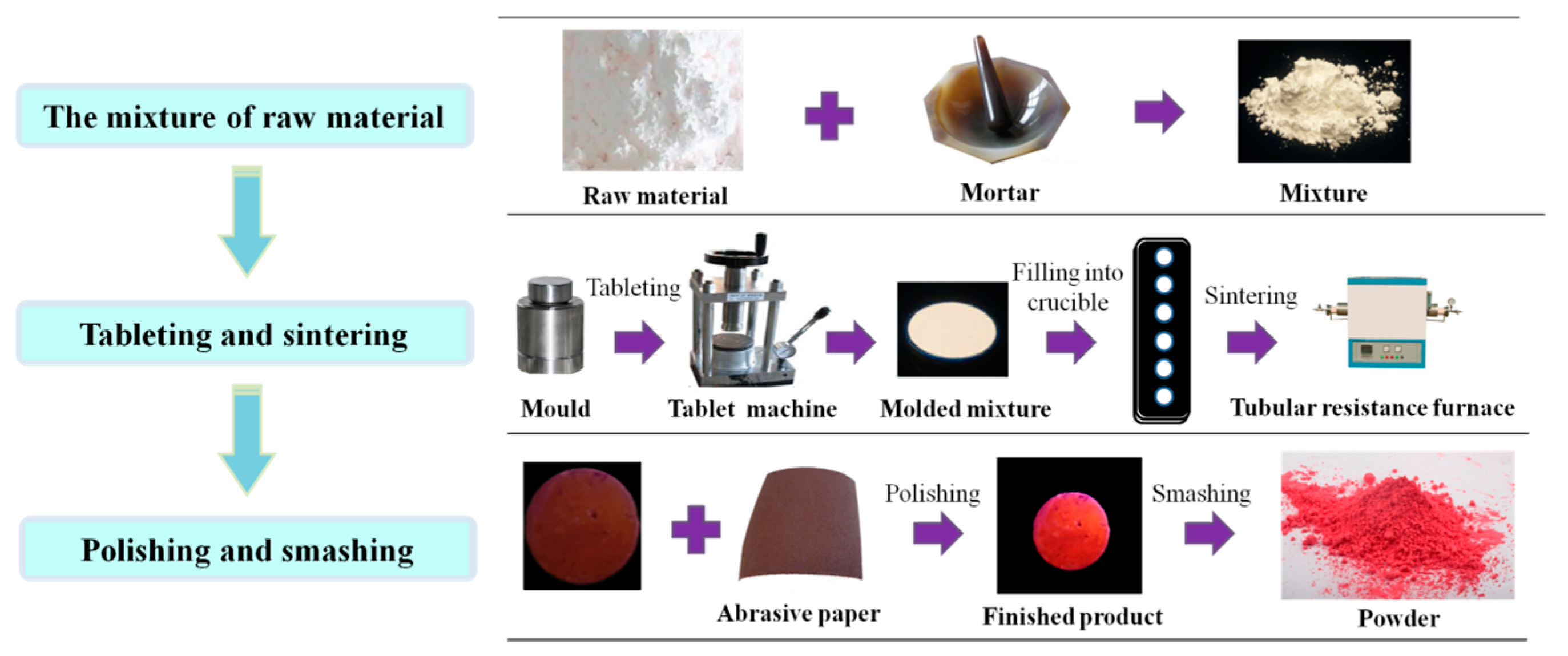
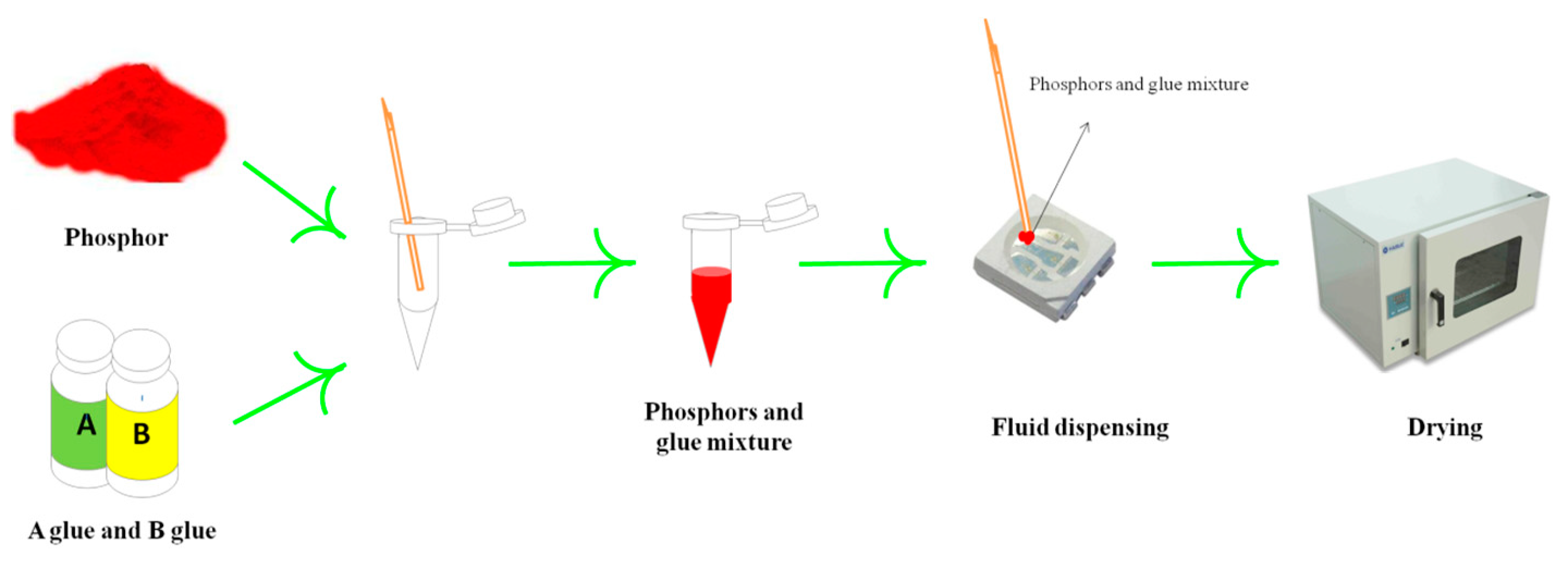
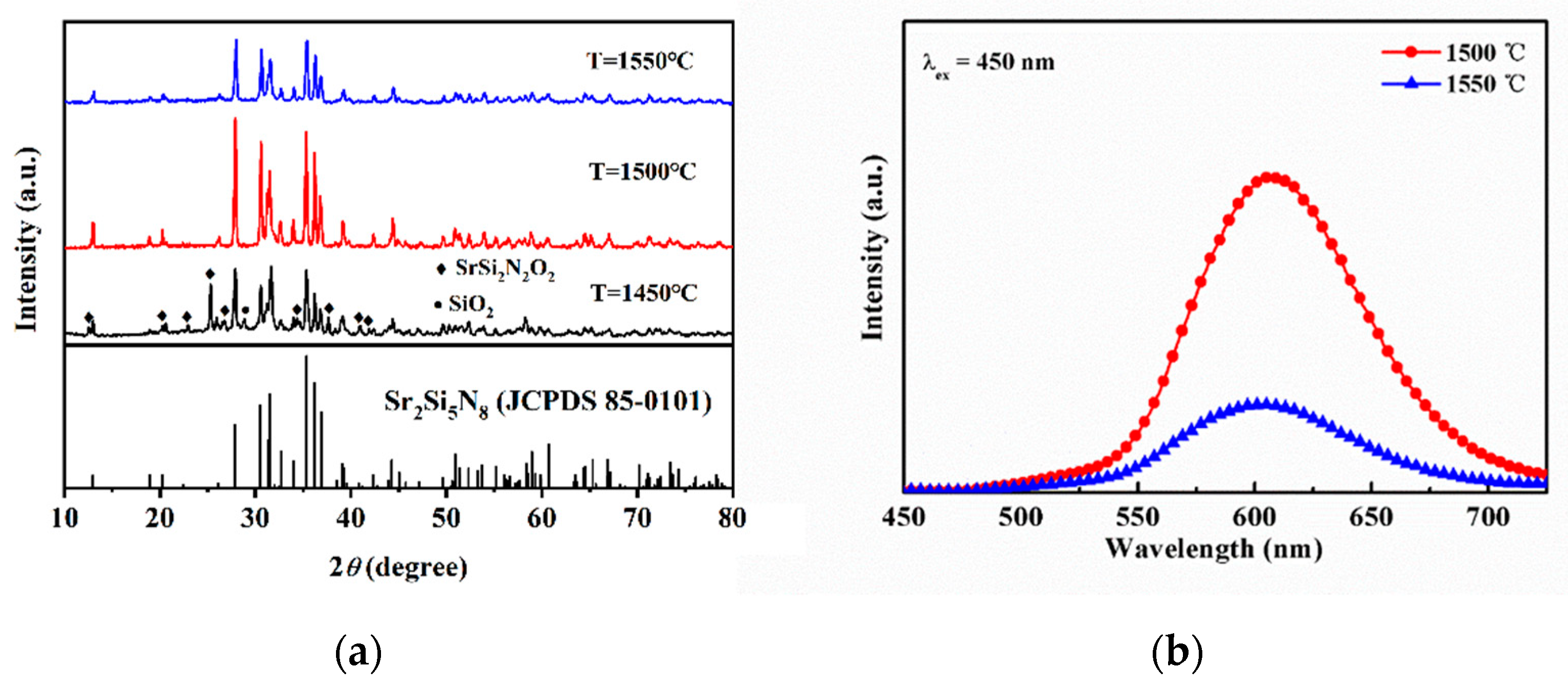
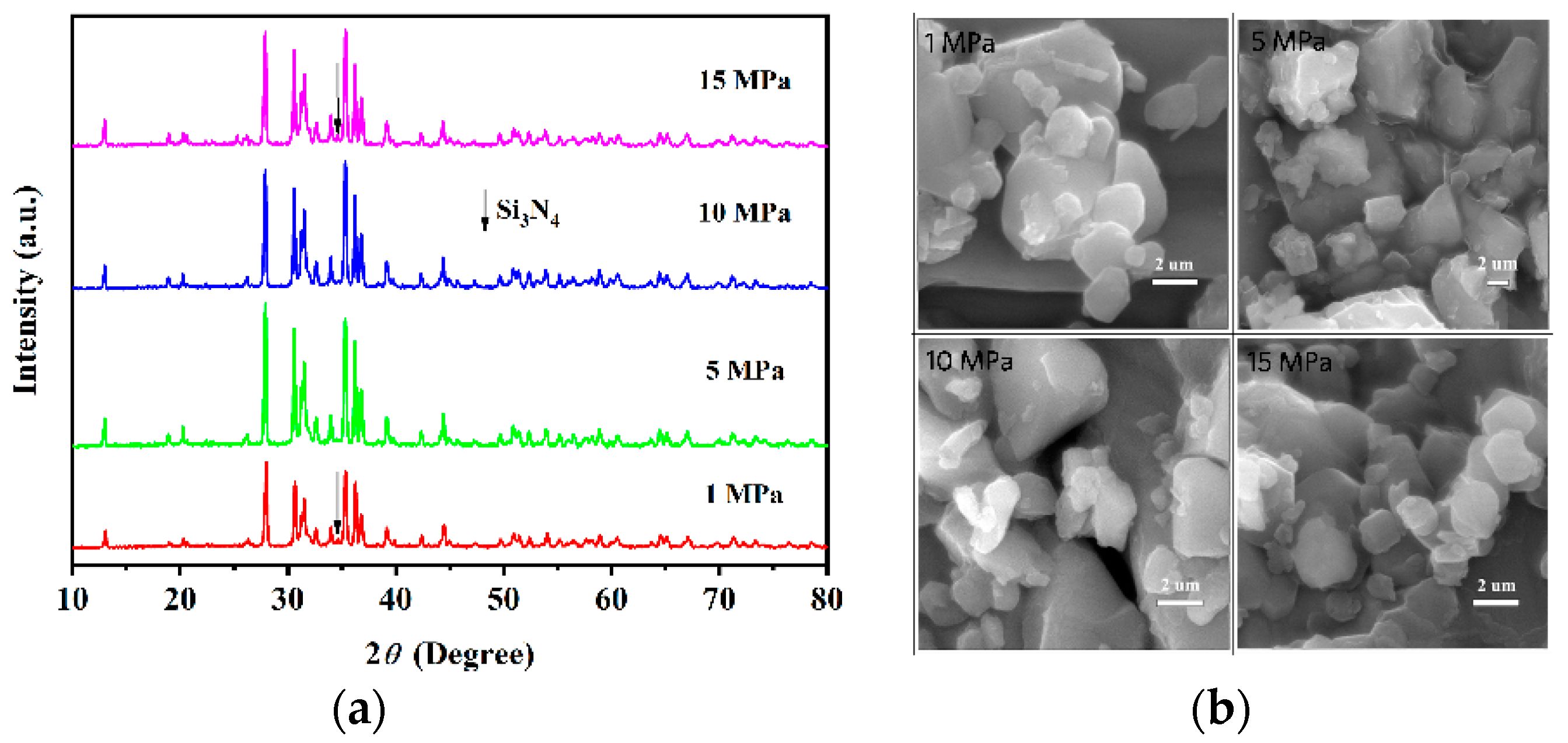
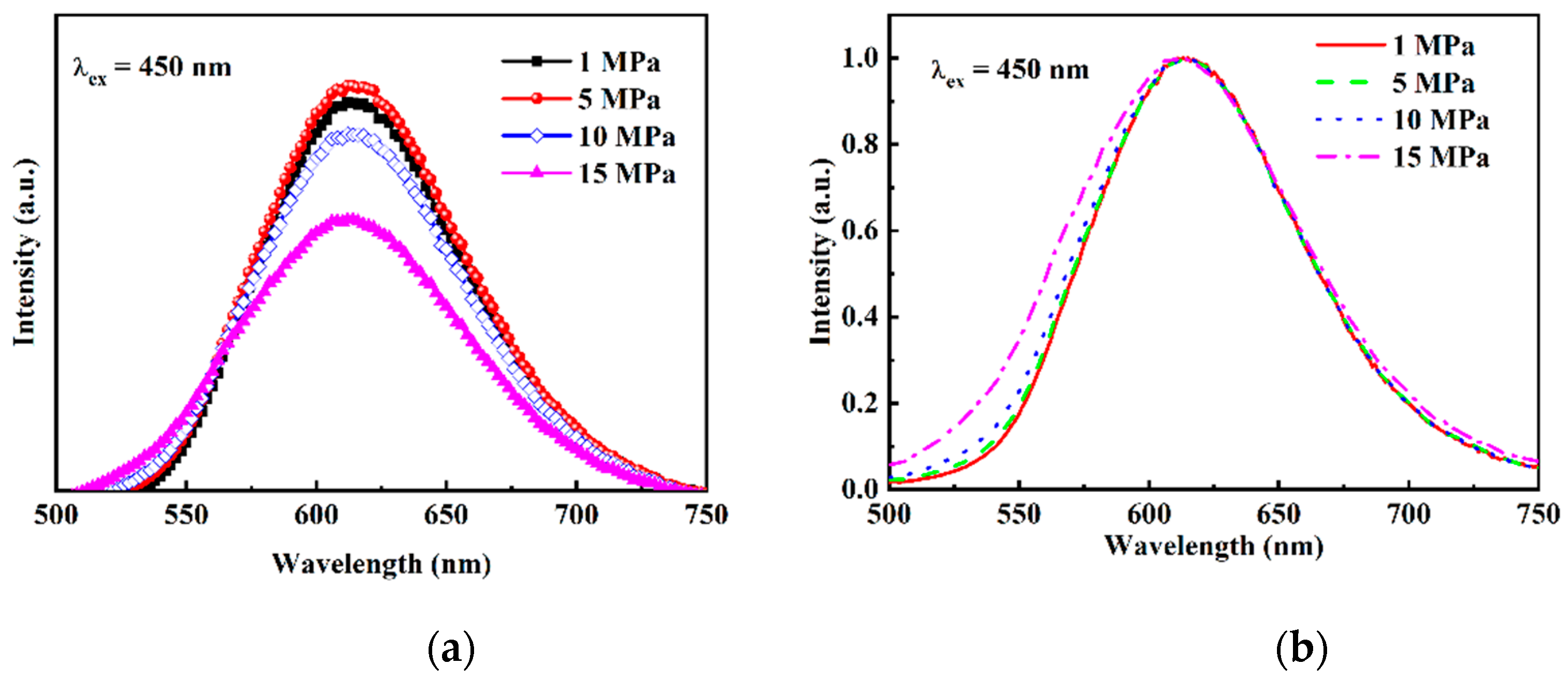


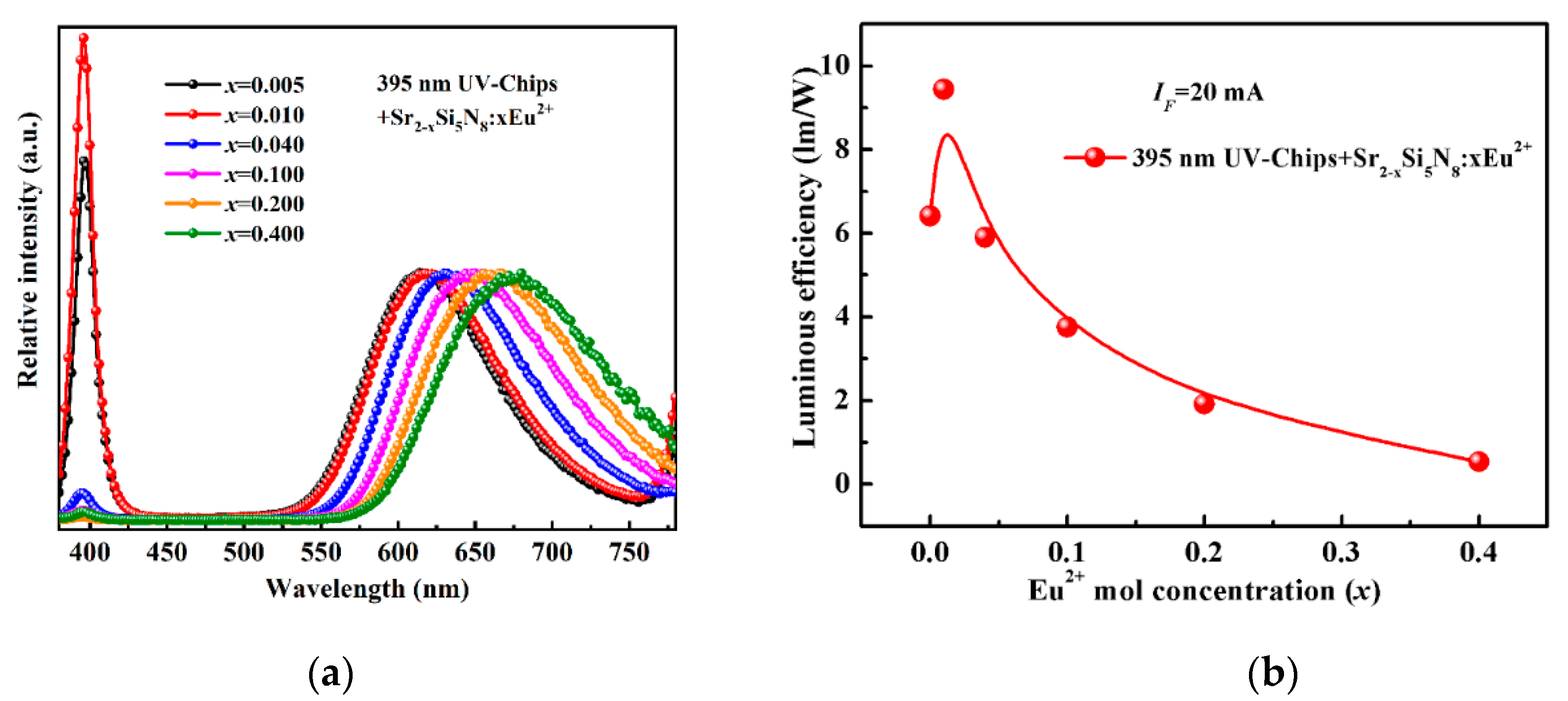
| Preparation | Preparation Condition | CIE (x,y) | Size (um) | λem (nm) | Ref. |
|---|---|---|---|---|---|
| Pellet method | 1500 °C + 5 MPa | (0.5902, 0.3749) | ~7 | 620 | This work |
| Low temperature modified solid-state metathesis | 1300 °C + 6 h + H2/N2 | (0.6382, 0.3612) | 5~10 | 628 | [21] |
| Sol-gel-nitridation method | 1300 °C + 3 h | (0.615, 0.385) | ~8 | 617 | [22] |
| Plasma-activated synthesis | 1350 °C + 6 min | ~ | ~1 | 626 | [18] |
| Multi-step heat treatment | 1100 °C + 1 h 1400 °C + 3 h 1600 °C + 3 h + N2 | ~ | ~ | 613 | [23] |
| High temperature solid-state method | 1400 °C + 9 h + H2/N2 | ~ | ~ | 612 | [24] |
| Acetate reduction synthesis | 1600 °C + 6 h + N2 | (0.638, 0.359) | 5 | 619 | [25] |
| x Values | 395 nm UV Chips + Sr2−xSi5N8: xEu2+ CIE(x, y) | |
|---|---|---|
| x | y | |
| 0.005 | 0.5852 | 0.3837 |
| 0.010 | 0.5902 | 0.3749 |
| 0.040 | 0.6367 | 0.3597 |
| 0.100 | 0.6600 | 0.3379 |
| 0.200 | 0.6749 | 0.3237 |
| 0.400 | 0.6790 | 0.3183 |
Publisher’s Note: MDPI stays neutral with regard to jurisdictional claims in published maps and institutional affiliations. |
© 2021 by the authors. Licensee MDPI, Basel, Switzerland. This article is an open access article distributed under the terms and conditions of the Creative Commons Attribution (CC BY) license (http://creativecommons.org/licenses/by/4.0/).
Share and Cite
Lan, Y.; Wang, D.; Xie, D.; Tan, J.; Li, B.; Zhang, M.; Chen, Y. Preparation of Red Phosphor Sr2Si5N8: Eu2+ by Pellet Method and Its Optical Characteristics. Coatings 2021, 11, 283. https://doi.org/10.3390/coatings11030283
Lan Y, Wang D, Xie D, Tan J, Li B, Zhang M, Chen Y. Preparation of Red Phosphor Sr2Si5N8: Eu2+ by Pellet Method and Its Optical Characteristics. Coatings. 2021; 11(3):283. https://doi.org/10.3390/coatings11030283
Chicago/Turabian StyleLan, Yuemei, Dong Wang, Dongliang Xie, Junhao Tan, Bowen Li, Mei Zhang, and Yan Chen. 2021. "Preparation of Red Phosphor Sr2Si5N8: Eu2+ by Pellet Method and Its Optical Characteristics" Coatings 11, no. 3: 283. https://doi.org/10.3390/coatings11030283
APA StyleLan, Y., Wang, D., Xie, D., Tan, J., Li, B., Zhang, M., & Chen, Y. (2021). Preparation of Red Phosphor Sr2Si5N8: Eu2+ by Pellet Method and Its Optical Characteristics. Coatings, 11(3), 283. https://doi.org/10.3390/coatings11030283






